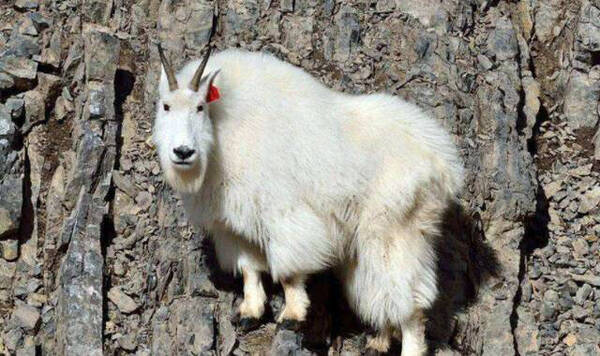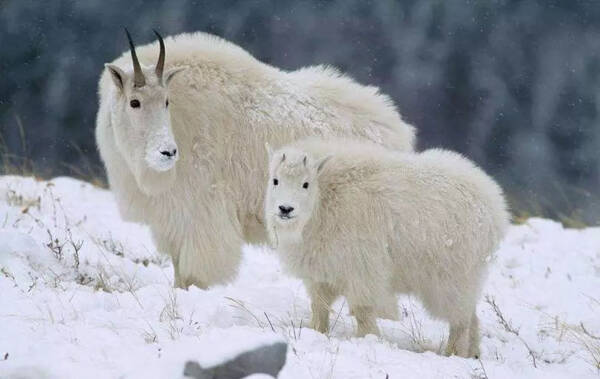Oreamnos americanus
IUCN
LCBasic Information
Scientific classification
- name:Oreamnos americanus
- Scientific Name:Oreamnos americanus,Mountain Goat,Rocky Mountain Goat
- Outline:Ungulata
- Family:Artiodactyla Bovidae Sheep
Vital signs
- length:130-160cm
- Weight:45-90kg
- lifetime:10-15years
Feature
Both males and females have short black horns, whiskers under their jaws, and are covered with a thick layer of long white hair.
Distribution and Habitat
The native range is from southeastern Alaska, western Washington, Montana and central Idaho. Native to the Northern Rocky Mountains, it has also been introduced to parts of South Dakota, Colorado and Washington.
Distributed in Canada (Alberta, British Columbia, Northwestern Yukon); United States (Alaska, Colorado - introduced, Idaho, Nevada - introduced, Oregon - introduced, South Dakota - introduced, Utah - introduced, Virginia, Washington, Wyoming - introduced).
Snow sheep prefer to live in cliffs or steep rocky areas in alpine and subalpine areas. They prefer terrain with sufficient escape (steep rocky areas), gentle slopes, and medium altitudes in the southern region. Migrate to low-lying areas in winter and go up to high altitude areas in summer. The living area belongs to the temperate terrestrial biozone. The altitude range is from sea level to 4000 meters.
Appearance
The snow sheep is 1.3-1.6 meters long, about 90-122 cm high at the shoulder, 15-20 cm long tail, and weighs about 45-90 kg. Females are nearly 30% smaller than males. The shoulder is protruding like a tumor. The limbs are short. There is a beard under the jaw, similar to a goat. The whole body is covered with a dense layer of long white hair. There is a small nose mirror on the side of the snout, and there is no groove in the middle of the upper lip. The female has 4 nipples. There are no scent glands in front of the eyes, but the male has a pair of large scent glands behind the ears, similar to the gazelle. Both males and females have short black horns, which are round and not very curved, without obvious wrinkles and tumors, and are 20-30 cm long. The fur is very fluffy and about 2 inches long. There are eight incisors in the front, so it can easily grab the grass on the ground.
Strong physique; with legs suitable for long-distance running; there are 4 toes on the feet, but the la
Details
Snow sheep (scientific name: Oreamnos americanus) is also known as Mountain Goat and Rocky Mountain Goat. There is no subspecies.

The degree of sociality of snow sheep varies throughout the year. They tend to form large herds in the winter and concentrate on salt licks in the spring, but they form smaller groups or live alone in the summer. They are active from sunrise to noon and again at dusk. Snow sheep establish dominance hierarchies at an early age through playful behavior. Males dominate during the breeding season, but hierarchies are unusual during the non-breeding season. At this time, adult females are dominant, while adult males are subordinate to females and young.
Snow sheep are most active in the early morning and evening, sometimes continuing to graze throughout the night. Eat a variety of plants that grow in the mountains, including grasses, herbs, sedges, ferns, mosses, lichens, twigs and leaves, from low-growing shrubs and conifers in higher altitude habitats. The main natural enemies are mountain lions, wolves and brown bears. In winter, they usually gather to form larger herds. Usually, male snow sheep live alone or in small groups, while females and their young live in groups during the day. They move slowly but steadily, and are very good at climbing and jumping between cliffs. As long as there is a place to step on, they can easily climb up and down cliffs no matter how steep they are. They usually live above the tree line in summer, and have to go down to lower places when the snow is deep in winter. In severe cold weather, they often hide in caves. The squatting posture is very similar to that of a dog, which is its unique posture, so that it can observe the enemy. Although mountain lions, wolves, bears and golden eagles sometimes hunt young snow sheep, their habitat itself ensures that they have few natural enemies. Sometimes they can fight with enemies with their horns and even kill them. Their biggest enemy is not animals but avalanches.
The breeding season of snow sheep begins in late November and lasts until early January. Mating occurs between October and December. The male uses the secretion of the horn gland or urine to mark and attract the female, then lowers his body to approach the female to win her favor. The gestation period of the female is 150-180 days. Between May and June, the female leaves the group to give birth. They choose very steep cliffs to avoid natural enemies. After giving birth, they return to the group. Some males and females still live in pairs after the mating period. Each litter has 1-2 cubs, and occasionally 3 cubs. One litter is born every 2 years. The cub can stand 10 minutes after birth, suckle in 20 minutes, and jump in 30 minutes. After a few days, it can follow the mother to climb rugged mountain roads. It is weaned after 3-4 months and stays with the mother until she gives birth to a new cub the following year. Snow sheep reach sexual maturity after 30 months and have a lifespan of about 10-15 years. The peak number of offspring produced by female goats is between 8 and 9 years old. Researchers have found that in this herding society, age and family status are positively correlated, and older females with higher social status tend to produce more offspring than younger females with lower rankings.

In Canada, the snow sheep habitat, which now exceeds 3,500, is protected in eight national parks (Banff, Glacier, Jasper, Kootenay, Haney, Revelstoke, Waterloo and Yoho), the Kluane National Park Reserve, and in the Kluane Wildlife Refuge. Numerous provincial parks and wildlife reserves throughout western and northern Canada provide additional protection and are set at varying levels. Limited hunting for Aboriginal people is permitted in some northern national parks and wildlife reserves, and authorized hunting is permitted in many provincial parks. Outside of protected areas, snow sheep are legally controlled by all provincial or territorial government agencies. In British Columbia, for example, harvest rates range from 0.4 to 9%, with an average of 1,100-1,200 snow sheep observed annually by residents and non-residents. In the Yukon, by contrast, the numbers are much lower, with only 3 to 15 sightings per year.
In the United States, major mitigation measures include habitat protection, introductions and reintroductions, and harvest regulation. State management has transplanted snow sheep in eight wildlife reserves throughout Canada and the contiguous United States. These six reserves have no Aboriginal populations. Many transplanted populations were established with only 10 to 15 animals. Wildlife agencies harvest in nine states and monitor populations to conservatively regulate populations. Snow sheep occur in nine federal protected areas: Alaska: Glacier Bay, Kenai Fjords and Wrangell-St. Elias National Parks and Kenai National Wildlife Refuge; Montana: Bison Range National Wildlife Refuge, Glacier National Park; South Dakota: Mount Rushmore National Monument; Washington State: North Cascades and Mount Rainier National Parks. However, most sheep populations are in national forests including many wilderness areas. The International Order of Rocky Mountain Goats, a private organization, raises funds for research and management of the species.
Listed in the IUCN Red List of Threatened Species in 2019 ver3.1 - Least Concern (LC).
Protect wildlife and eliminate game.
Maintaining ecological balance is everyone's responsibility!








